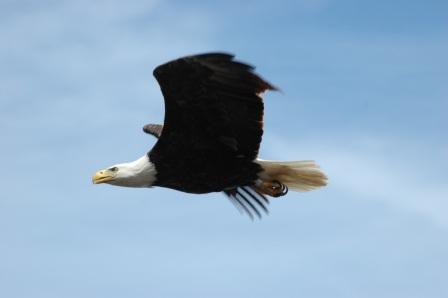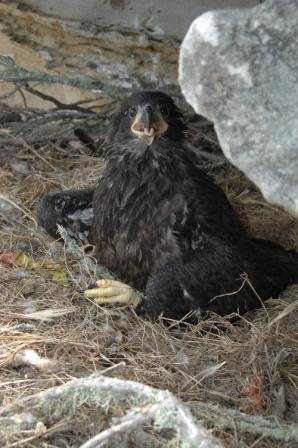
Photo credit: Dr. Peter Sharpe
In 1782, six years after the Declaration of Independence was signed and a new nation was born, Congress chose the bald eagle to be the national emblem of the United States. Today, the eagle is printed, painted and carved on everything having anything to do with our government. But how often do Americans even notice or consciously think of this great bird?
Probably not that often. So in honor of the Fourth of July, Wild Things is taking time to raise eagle awareness and consciousness to a new level because the bald eagle is so much more than a banner waving bird on the back of a dollar bill.
The bald eagle or Haliaeetus leucocephalus is the second largest bird of prey in North America. Averaging more than three feet in length with a wingspan of 6 to 7.5 feet, the bald eagle is one big bird. And while Congress is still mostly dominated by men, the female bald eagle is 25 percent larger than the male. Does this mean she dominates bald eagle meetings? Stay tuned…
Aside from their size difference, male and female bald eagles sport the same striking look with chocolate brown bodies, offset by white head and tail feathers accented by a gold-yellow beak, matching gold-yellow feet and light-yellow eyes. Colors that give a very professional yet distinguished look, the power suit of the bird kingdom.
Bald eagles are members of the hawk family called Accipitridae. This family of birds shares certain traits including “hooked beaks for tearing flesh, and strong legs and sharp talons for grasping, holding, and in some cases killing prey,” according to The Sibley Guide to Bird Life & Behavior.
But best of all, bald eagles and their closest relatives “have eyesight that is four to eight times better than that of humans.” For eagles, the gift of super human vision is handy for hunting and capturing prey. This allows them to be excellent fishermen, I mean fisherpeople, I mean fishereagles. They are actually members of a group called fish-eagles and this is why eagles are most commonly found living along the coast or near inland lakes and rivers.
And the eagles living on the Channel Islands are no exception.
“Eighty-five to 95 percent of what’s brought to the nest is fish; they also go for gulls and other marine birds. The only other mammal I’ve found is a ground squirrel,” said Dr. Peter Sharpe, a wildlife biologist who tags and tracks the eagles on the Channel Islands for the Institute of Wildlife Studies.
Eagles have a surprisingly diverse fish diet too. “Mostly mackerel, smelt and also deepwater fish that fishermen must let go, like rockfish and sometimes garibaldis and flying fish,” said Sharpe. “Eagles just swoop down and grab fish at the surface; they couldn’t reach deepwater fish on their own.”
Discarded fish left from fishermen are actually the perfect meal for fishereagles because in reality eagles aren’t fans of doing their own hunting. “Eagles are primarily scavengers; they prefer to eat things that are already dead,” said Sharpe. “First, they go scavenging, then pirating and then they go hunting last if necessary.”
The energy bald eagles save by scavenging is put to good use at the beginning of the mating season when they perform spectacular aerial stunts, their version of fireworks. According to the Birds of North America database this includes the “cartwheel display, in which the courting pair fly to great altitude, lock talons, and tumble/cartwheel back toward earth” and the “so-called roller-coaster flight, in which eagles will fly to great altitude, fold wings, and dive directly to earth.”
Both moves are definitely crazy and should easily qualify bald eagles as the daredevils of the bird world. Each dive requires “swooping back up at the last instance to avoid colliding with the ground.” And there have been cases where eagles get a little too carried away.
In April, The Associated Press ran a story by Rachel D’Oro about two eagles that got so caught up in the throes of love during their courtship dive that they crashed headfirst into an Alaskan snowbank. The male bald eagle died and the female was rescued. Biologists quoted in the story chalked the crash up to “raging hormones” and that the eagles “just lose track of what they’re doing.” The female eagle is recovering and is “less dazed and confused every day.”
Ah, the joys of hormonal love.
I asked Dr. Sharpe if he’s witnessed eagle fireworks on the Channel Islands and he has not. “It’s just part of the ritual, the actual mating takes place on the ground or a perch somewhere,” said Sharpe. “I don’t think they do it frequently. We are usually out there after they’ve laid eggs and that [the courtship dive] takes place really early in the breeding season; it’s a pair bonding type of thing.”
Eagles make the pair bonding ritual worthwhile by mating for life. “If they are unsuccessful in nesting a couple of years, they might break up, but usually if they are successful for a few years they stay together,” said Sharpe. “The longest pair I’ve tracked became mates in 1992 and stayed together until 2005 when one of the birds disappeared, which means that bird probably died.”
Until death do us part said the eagles.
And to the bald eagle’s credit, in a relationship they practice their own version of democracy within the breading territories established by each pair. “Both adults incubate the eggs, they share the responsibility pretty much fifty fifty throughout the day and the female sits on the eggs all night while the male perches close by,” said Sharpe. “Once the chicks hatch the females stay at the nest more and the males do more of the hunting. This may be the reason why females are 25 percent bigger than males, to better protect and shield the chicks when they are born.”

Photo credit: Dr. Peter Sharpe
So instead on using their extra girth to dominate males, female eagles use it to protect the next generation. If only we the people of the United States had treated our national emblem with the same respect eagles treat each other.
Thanks to the mass killing of eagles and to the ravages of DDT and other pesticides eagle populations plunged across the United States. “Eagles were down to about 400 pairs in the lower 48 states by the 1960s,” said Sharpe.
Alas, the Montrose Chemical Corporation’s manufacturing plant in Torrance dumped hundreds of tons of DDT into the ocean, contaminating fish and other marine life and ultimately killing hundreds of birds, including the bald eagle. DDT effectively wiped out the bald eagle on the Channel Islands by the mid-1900’s.
But scientists and researchers are bringing the bald eagle back. Starting in 2002, about 12 chicks were reintroduced every year for five years on Santa Cruz Island. These eagles reached breeding age in 2006, leading to the first two chicks hatched on the Channel Islands in more than 50 years. Now there are 11 active nests on the Channel Islands and you can watch the action on the internet via the eagle nest cams by going to www.iws.org.
It’s not too late to check the eagles out. “Two eaglets will start flying around July 10th on the West End nest and an eaglet is still hanging around the Pelican Harbor nest on Santa Cruz,” said Sharpe. So take time to tune in and show your appreciation for the bald eagle, the symbol of democracy, freedom and the pursuit of happiness.
“power suit of the bird kingdom” that’s so awesome, i just had to repeat it. 🙂